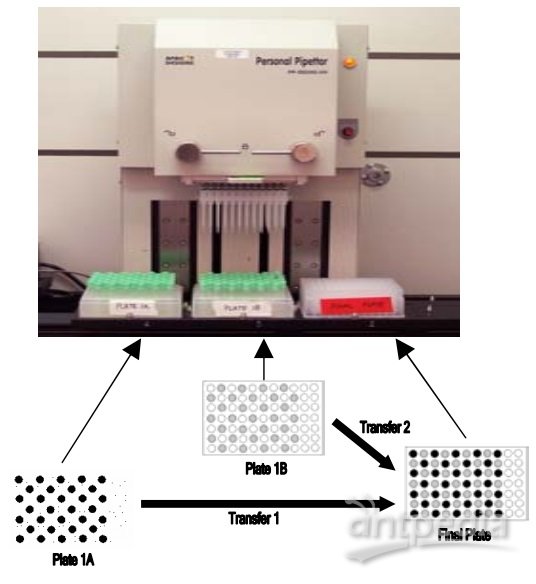应用领域:其他生命科学,移动实验室相关,其他生命科学,移动实验室相关
检测样品:试剂
检测项目:实验
参考标准:www.apricotdesigns.com
PERSONAL PIPETTOR全自动移液工作站是Apricot Designs研发生产的集多种移液功能于一身的紧凑型全自动移液工作站,具有高效、便捷、精准的特性,能同时兼容1/8/12/16/24/96/384通道的液体处理,开放式的设计可以便于整合叠板机和机械臂等。
特点和优势
1. 集多种移液功能于一身,仅需单击运行,即可完成多种不同类型的切换;2. 5个功能板位+1个洗针槽/废液槽;3. 1/8/12/16/24/96/384通道移液;4. Personal Pipettor+无人值守, 可自动更换吸头;5. 简单直观的iPad/Microsoft Surface™/PC操作界面;6. 可选择使用有线或无线操控仪器;7. 适用于96/384孔板移液和逐行/逐列梯度稀释;8. 移液工作站、锁头和EZ-Load吸头三合一,密封良好,确保实验精确、可靠和可重复;9. 可搭载洗针系统/条码扫描/震荡器/控温模块;10. 可整合微孔板叠板机和机械手,真正实现自动化无人值守;11. 体积小巧,最大化节省空间,适合放置于多数标准通风橱。
以下为有关PERSONAL PIPETTOR全自动移液工作站进行 LC/MS/MS样品的采集,请参考:
Overview
Purpose•Show a new and innovative way to collect, store, and prepare plasma samples using microtainers.•Show that the use of microtainers has saved considerable time and effort in both the Pharmacokinetics (PK) and Analytical groups.•Show that there are no compound stability or non-specific binding issues with the compounds tested by storing plasma samples in microtainers over long periods of time.•Show that using microtainers has minimized clotting issues in plasma samples.
MethodPKAnimal dosing→collection in microtainer→ centrifuge→store in freezerAnalytical
Receive samples From PK→Arrange in 96-well plate→transfer samples by Apricot (See Figure 1)→Sample prep
MethodSample preparation 100 uL plasma sample + 10 µL internal standard + 400 µL acetonitrile to precipitate the proteins - 450 µL of the supernatant dry down under nitrogen reconstitute with 100 µL of 5% methanol
Column Higgins TARGA, C18 (30 x 0.5mm, 5 µm) Inject 10 µLRepresentative Method Initial 0.5 minute hold followed by linear gradient of 25-85% B over 1.5 minutes 100 µL/minute flowrate Mobile Phase A: 0.25% Formic Acid in Water Mobile Phase B: 0.25% Formic Acid in MethanolInstrumentation and Hardware PE Sciex API 3000 using TIS HTS PAL LEAP Autosampler Shimadzu Pumps and System Controller Data processed with Analyst version 1.3
Figure 1. What is a microtainer?

Microtainers are collection tubes that are used to stabilize and separate whole blood into plasma and blood cell (BC) fractions.
Microtainers can contain a polymer gel separator and the walls can be coated with an anticoagulant (i.e. Heparin or EDTA).
Benefits of using microtainers as a sample collection and storage tube:
• No loss of sample
• Minimal sample transfers
• Minimal labeling
• No decanting
Figure 2. A semi-automated approach using the Apricot Personal Pipettor to transfer samples from microtainers to 96-well plates.

Table 1. Statistical Analysis of THRX-776005 Stability Study in microtainers based on average concentrations.

Figure 3. Stability of THRX-776005 in microtainers over a period of time.

Figure 4. PK profile of THRX-502038 comparing plasma samples collected in microtainers versus samples collected in Eppendorfs.

Results and Conclusion
Using microtainers as a collection, preparation, and storage tube has increased sample processing productivity by 50-fold.
The use of microtainers has negated the problem of plasma clots.
Compound instability in the microtainer is minimal as shown in Figure 3 and defined in Table 1.
Non-specific binding of compounds during routine use and storage has not been seen as shown in Figure 3.
There were no great differences between using Eppendorfs (original method) and using microtainers (current method) to store plasma samples as shown in Figure 4.
To date >20,000 samples have been processed using this method.
The use of microtainers with heparin has shown no evidence of MS signal suppression of our compounds. (Data not shown)